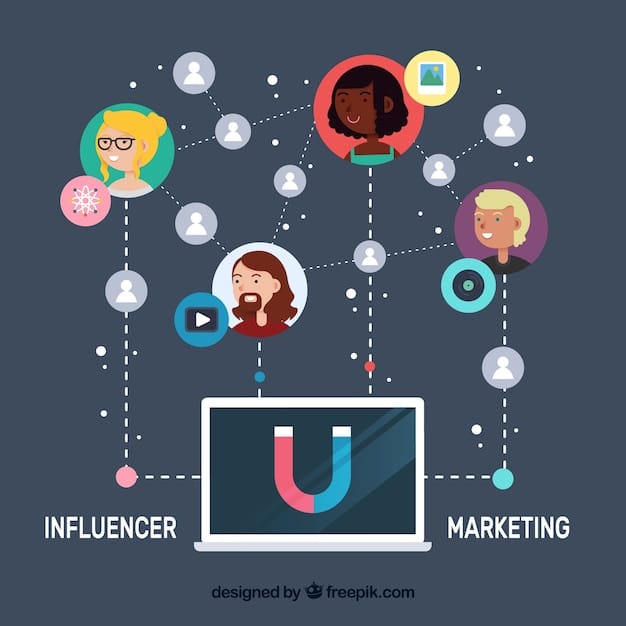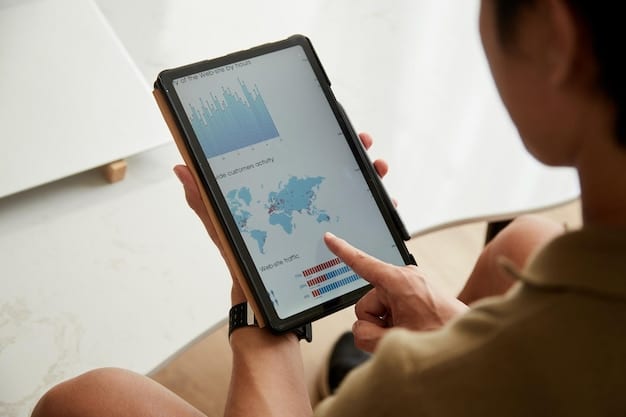Podcast Sponsorships: Increase Your Income by 30% Today

Achieving significant revenue growth in podcasting, specifically a 30% increase through strategic sponsorship negotiation, involves understanding fair market value, crafting compelling pitch decks, and mastering the art of deal structuring to align sponsor goals with audience engagement.
In the dynamic world of podcasting, unlocking significant revenue streams is often synonymous with mastering the art of sponsorship. For many content creators, the goal isn’t just to secure any deal, but to negotiate partnerships that genuinely skyrocket their earnings. This comprehensive guide will delve into strategies to achieve a formidable 30% increase in your income through astute podcast sponsorships: negotiate deals that increase your income by 30%, moving beyond basic rates to forge mutually beneficial and highly lucrative collaborations.
Understanding the Sponsorship Landscape
Before diving into negotiation tactics, it’s crucial to grasp the evolving nature of podcast sponsorships. The industry has matured, moving beyond simple ad reads to embrace integrated campaigns that offer deeper value for brands. This shift demands a more sophisticated approach from podcasters, focusing on demonstrating clear return on investment (ROI) for potential sponsors.
The marketplace for podcast advertising is competitive, but also expansive. Advertisers are increasingly recognizing the intimate connection podcasters build with their audience, leading to higher engagement rates compared to traditional media. This unique bond is your strongest asset when approaching brands.
Types of Sponsorships
Understanding the different models of sponsorship can help you tailor your pitch and negotiate better terms.
- Pre-Roll/Mid-Roll/Post-Roll Ads: These are the most common, where your ad read is placed at the beginning, middle, or end of an episode. Mid-roll ads typically command the highest rates due to higher listener retention.
- Integrated Content: This involves weaving sponsored content naturally into your podcast’s narrative, making it feel less like an advertisement and more like an organic part of the show.
- Brand Mentions/Product Placements: Subtle mentions or use of a product within your regular programming, often less intrusive than traditional ads.
- Series Sponsorships: A brand sponsors an entire season or a multi-episode series, offering sustained exposure and often a higher overall deal value.
Each type offers different levels of integration and, consequently, different value propositions. Your ability to offer a mix of these, customized to a brand’s needs, will enhance your negotiation power. Moving beyond basic ad reads to integrated content can significantly uplift your value proposition.
Identifying suitable sponsors is also paramount. Rather than a scattergun approach, focus on brands whose values align with your podcast’s content and audience demographics. A thoughtful match leads to more authentic promotions and better results for the sponsor, fostering long-term relationships.
Quantifying Your Value: Data and Demographics
To negotiate effectively, you must first understand your intrinsic value. This isn’t just about download numbers; it’s about the depth of your audience engagement, their demographics, and the unique connection you share. Sponsors are not just buying impressions; they are buying access to a highly specific and often highly engaged listener base.
Download metrics, while important, are merely the starting point. Dig deeper into your analytics to uncover the story behind those numbers. Who are your listeners? What are their interests, purchasing habits, and pain points? This qualitative data is gold when presenting your value proposition to a brand.
Key Metrics to Highlight
When presenting your podcast, these metrics are crucial for outlining your market value:
- Listener Demographics: Age, gender, location, income, education level — all paint a picture of who is listening.
- Engagement Rates: Completion rates, social media interactions, email list sign-ups, and website visits indicate how deeply your audience engages with your content.
- Listener Feedback: Testimonials, reviews, and anecdotal evidence of audience loyalty.
- Growth Trends: Demonstrate consistent growth in downloads and engagement over time, showing a healthy and expanding audience.
Beyond these, consider the niche appeal of your podcast. A smaller, highly engaged niche audience can often be more valuable to a specific advertiser than a massive, generalized one. Brands appreciate precision targeting, and your detailed audience profile provides that.

Prepare a concise, compelling media kit that distills this data into an easily digestible format. This kit serves as your professional resume, showcasing your podcast’s unique selling points and why it’s an ideal platform for a sponsor’s message. A well-crafted media kit can significantly influence a brand’s perception of your podcast’s value.
Crafting the Irresistible Pitch Deck
Your pitch deck is your opportunity to tell your podcast’s story and articulate its value proposition to potential sponsors. It must be professional, visually appealing, and highlight how a partnership will directly benefit the brand. Move beyond a generic template; each pitch should be customized to the prospective sponsor.
A strong pitch deck is more than just a list of your stats; it’s a narrative that connects the brand’s objectives with your audience’s interests and your podcast’s unique content. Think from the sponsor’s perspective: What problem are they trying to solve? How can your podcast be the solution?
Essential Components of a Pitch Deck
A comprehensive pitch deck should include:
- Introduction: A compelling overview of your podcast, its mission, and its unique appeal.
- Audience Profile: Detailed demographics and psychographics, explaining why your audience is a perfect fit for their brand.
- Key Metrics: Downloads, engagement, and growth trends, presented clearly and concisely.
- Sponsorship Opportunities: Outline the different types of sponsorships you offer, from standard ad reads to integrated campaigns.
- Case Studies/Success Stories: If you have previous sponsorships, showcase the positive results achieved.
- Call to Action: A clear next step for the brand, such as scheduling a meeting to discuss a customized proposal.
Tailor your pitch deck to each brand, demonstrating that you’ve researched their business and understand their marketing objectives. This personalization shows professionalism and a genuine interest in a mutually beneficial partnership, not just securing a quick deal.
Emphasize the unique opportunity your podcast provides for relationship marketing. Unlike traditional advertising, podcasting allows brands to connect with consumers authentically through your voice and trust. This is a powerful selling point that can elevate your pitch beyond mere numbers.
Strategic Negotiation: Beyond the Rates
Negotiation is an art form, especially when moving beyond standard CPM (cost per mille/thousand downloads) rates. To increase your income by 30%, you need to think creatively about deal structures, value-added components, and long-term partnerships. The goal is to maximize the overall value of the deal, not just the per-episode rate.
Start by having a clear understanding of your minimum acceptable rate, but be prepared to push for more. Research industry benchmarks and be confident in your podcast’s unique value. Never undervalue your content or your audience.
Key Negotiation Principles
Consider these points for a robust negotiation strategy:
- Understand Their Goals: Ask probing questions to understand the sponsor’s specific marketing objectives. Is it brand awareness, lead generation, or sales? Tailor your proposal to meet these goals.
- Offer Value-Added Services: Beyond ad reads, consider offering social media promotion, newsletter mentions, or host read endorsements. These add value without significantly increasing your workload.
- Flexible Deal Structures: Propose tiered packages (e.g., bronze, silver, gold) or performance-based incentives. For instance, a base rate plus commission on sales driven by your unique promo code.
- Long-Term Partnerships: Advocate for multi-episode or multi-season deals. This provides stability for both parties and allows for deeper brand integration over time, often at a better per-episode rate.
- Don’t Be Afraid to Walk Away: If a deal doesn’t align with your values or fair market value, be prepared to decline. This demonstrates confidence and can sometimes lead to a better offer.
Remember that negotiation is a two-way street. Be open to compromise and creative solutions that benefit both parties. A successful negotiation leaves both you and the sponsor feeling good about the partnership and eager for future collaboration.
Leverage your unique content and personal connection with your audience. Explain how your authentic endorsement will resonate more deeply than generic advertisements, leading to higher engagement and conversions for the sponsor. This qualitative advantage is incredibly powerful.
Legal and Financial Considerations
Once you’ve agreed on terms, solidifying the partnership with a clear contract is paramount. This protects both parties and ensures all expectations are clearly defined. Don’t rely on verbal agreements; get everything in writing.
For more complex deals, especially those involving performance incentives or long-term commitments, consider seeking legal counsel. A small investment in legal review can prevent significant headaches down the line.
Contractual Must-Haves
Ensure your contracts cover these essential details:
- Scope of Work: Clearly define how many ads, their length, placement, and any additional promotional activities (e.g., social media posts).
- Payment Terms: Specify the total compensation, payment schedule (e.g., net 30, split payments), and payment method.
- Deliverables: Outline what each party is responsible for, including ad copy submission, approval processes, and reporting.
- Exclusivity Clauses: If applicable, specify any categories where you agree not to work with competing brands for a certain period.
- Cancellation Clause: What happens if either party needs to terminate the agreement? Include terms for early termination.
- Reporting and Analytics: How will performance be tracked and reported? Agree on the metrics and frequency of reporting.
Transparency is key in all financial dealings. Provide clear invoices and adhere to the agreed-upon payment schedule. Professionalism in financial management builds trust and encourages repeat business from satisfied sponsors.
Be aware of tax implications. In the US, sponsorship income is taxable, and understanding your obligations (e.g., 1099-NEC forms) is crucial. Consult with a tax professional to ensure compliance and avoid unexpected liabilities.
Measuring Success and Optimizing for Growth
Securing a sponsorship deal is only half the battle; proving its value and continually optimizing your approach is how you sustain growth. Data-driven reporting to your sponsors is essential for showcasing ROI and building long-term relationships.
Beyond simply providing numbers, interpret the data for your sponsors. What do the metrics mean for their campaign? How did your audience respond? Offer insights and suggestions for future optimizations, demonstrating your active partnership approach.
Reporting and Reinforcement
Effective reporting should include:
- Download Numbers & Trends: Show how episodes with ads performed overall.
- Website Traffic/Conversions: If using unique landing pages or promo codes, report on how many listeners converted.
- Audience Feedback: Share positive feedback or questions related to the sponsor, if appropriate.
- Social Media Engagement: Metrics on any social posts or mentions related to the sponsorship.
- Analysis & Insights: Don’t just present data; explain what it means and how you can further optimize results.

Use insights gained from campaign performance to refine your pitch for future sponsors. What worked well? What could be improved? Continuously learning from your campaigns allows you to offer increasingly effective partnerships.
Foster genuine relationships with your sponsors. Regular check-ins, thanking them for their partnership, and proactive communication can turn a single deal into a series of lucrative collaborations. Long-term partners are often your most valuable asset.
Don’t be afraid to experiment with different ad formats, calls to action, or integration styles. A/B testing can provide valuable insights into what resonates best with your audience and generates the highest ROI for your sponsors, further increasing your negotiating leverage.
Future-Proofing Your Sponsorship Strategy
The podcast industry is constantly evolving, and so too must your sponsorship strategy. Staying abreast of new trends, technologies, and audience behaviors will ensure your podcast remains an attractive platform for advertisers and continues to deliver that impressive 30% income growth.
Embrace innovation, whether it’s through dynamic ad insertion, interactive ad formats, or exploring new monetization models. A proactive approach to industry changes positions you as a forward-thinking partner for brands.
Emerging Trends in Podcast Sponsorships
Keep an eye on these developments to stay ahead:
- Programmatic Advertising: The automated buying and selling of ad space, offering efficiency for both podcasters and advertisers.
- Data Privacy & Targeting: As privacy regulations tighten, first-party data and contextual targeting become even more valuable.
- Creator Economy & Direct-to-Consumer: More brands are looking to partner directly with creators for authentic endorsements.
- Video Podcasts: The rise of video-first podcasts opens up new visual sponsorship opportunities.
Continually refine your content strategy. A high-quality, consistent, and engaging podcast is the foundation for attracting and retaining top-tier sponsors. Invest in your craft, your equipment, and your content to ensure your platform remains premium.
Network within the industry. Attend conferences, join online communities, and connect with other podcasters and ad agencies. These connections can lead to new opportunities, insights, and collaborative ventures that bolster your sponsorship income.
Finally, remember that authentic connection with your audience is your superpower. Brands are increasingly seeking that genuine trust. Nurture your community, listen to their feedback, and continue to create content they love. This audience loyalty is the bedrock of successful and ever-growing sponsorship revenue.
| Key Insight | Brief Description |
|---|---|
| 📊 Optimize Metrics | Understand and convey your true audience value beyond downloads. |
| ✍️ Craft compelling pitches | Tailor pitch decks to specific sponsor goals, highlighting mutual benefit. |
| 🤝 Strategic Negotiation | Focus on value-added services and long-term deals, not just rates. |
| 📈 Prove ROI & Adapt | Provide data-driven reports and stay updated on industry trends. |
Frequently Asked Questions
▼
To pinpoint your value, analyze your download numbers alongside listener demographics. Crucially, go beyond CPM by quantifying engagement: completion rates, social media activity, and direct listener feedback. Niche appeal and your unique connection with the audience also significantly boost perceived value, allowing you to command higher rates.
▼
Start with thorough research, identifying brands that genuinely align with your podcast’s content and audience. Craft a personalized pitch deck showcasing your unique value proposition, detailed audience insights, and how a partnership solves their marketing objectives. Prioritize quality over quantity in your outreach, demonstrating genuine interest in a mutually beneficial collaboration.
▼
Value-added services like social media shout-outs, newsletter mentions, or integrated content beyond simple ad reads significantly enhance a sponsorship’s appeal and perceived value. By offering more than just an ad slot, you justify a higher price point and demonstrate a holistic partnership approach, making your podcast a more attractive investment for brands.
▼
Beyond basic download numbers, sponsors value insights into engagement and conversions. Report on unique promo code redemptions, website traffic driven, listener feedback, and any social media interactions related to their campaign. Providing an analysis of what worked, along with suggestions for future optimization, proves ROI and strengthens long-term relationships.
▼
Always get all terms in writing, encompassing scope of work, payment schedules, deliverables, and clear termination clauses. Ensure intellectual property rights for ad creative are defined. For complex deals, consulting an attorney is highly recommended to protect both parties and prevent future disputes, fostering a professional and trustworthy partnership.
Conclusion
Achieving a 30% increase in your podcast income through sponsorships is not merely about attracting more advertisers; it’s about strategically transforming how you perceive and present your podcast’s value. By deeply understanding your audience, crafting compelling pitches, mastering negotiation beyond basic rates, and consistently demonstrating ROI, you can elevate your podcast from a hobby to a truly lucrative enterprise. The future of podcasting income lies in these genuine, data-driven, and mutually beneficial partnerships.





